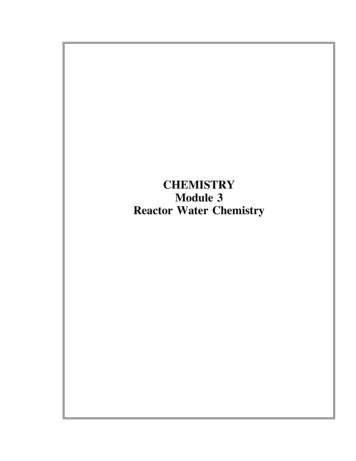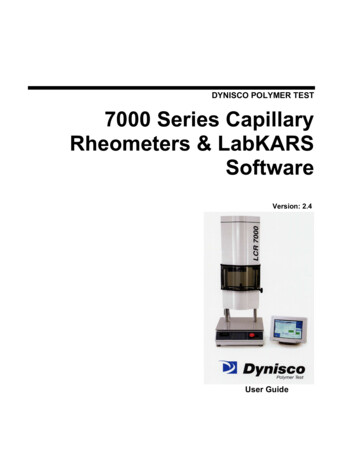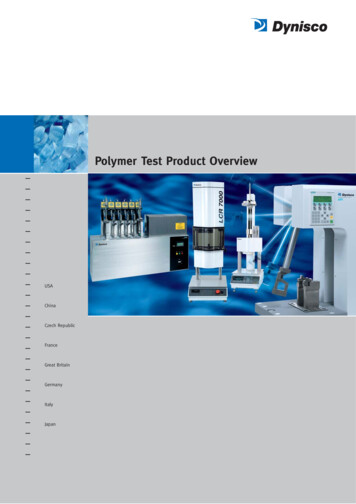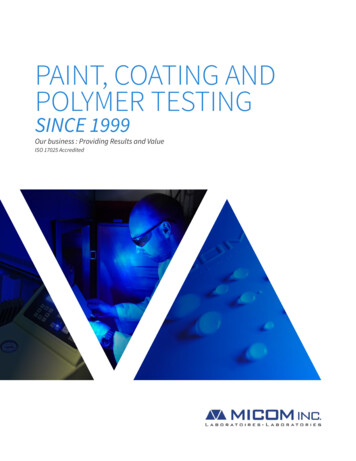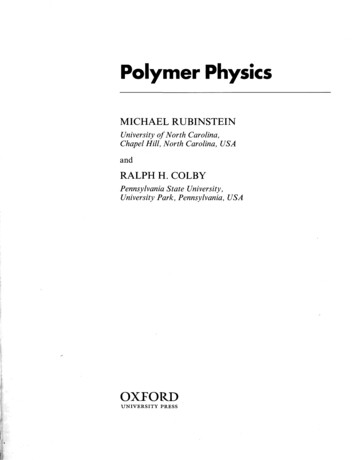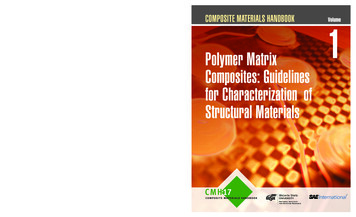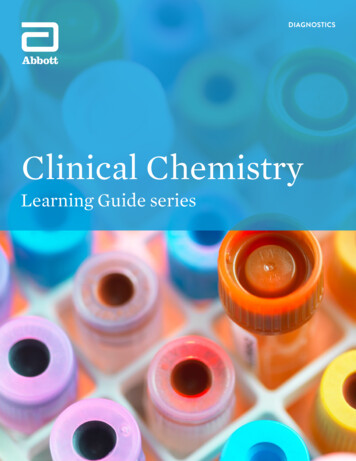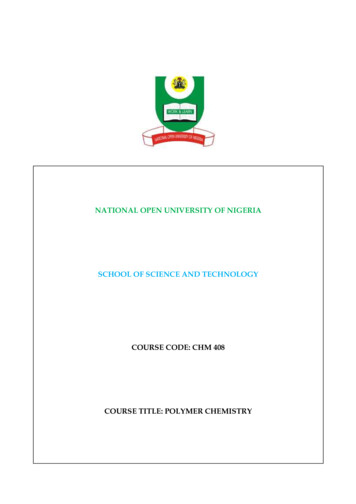
Transcription
NATIONAL OPEN UNIVERSITY OF NIGERIASCHOOL OF SCIENCE AND TECHNOLOGYCOURSE CODE: CHM 408COURSE TITLE: POLYMER CHEMISTRY1
CHM 408POLYMER CHEMISTRYCourse Developer:Igwemmar, Noela ChinyeluCourse GuideIntroductionWelcome to this chemistry course. We have packaged this chemistry course in such a way thatyou will learn chemistry using a technique peculiar to the open learn system. This technique hasbeen adopted by the National Open University of Nigeria in most of the courses offered tostudents. The language is simple, interesting and specific to the subject, ‘Polymer Chemistry’.This course guide tells you briefly about the course, the course materials available, how to workwith them and maximize your learning through effective time management. Polymer chemistryis a two-unit degree course for all students offering Bachelor of Science (B.Sc.) Chemistry.2
Polymers are no longer regarded as novelties or cheap substitutes for traditional materials such asmetals, wood, glass and ceramic. They are now an important class of materials in their ownrights. Examples of their use abound everywhere, in the homes, schools, offices and factories.Relationship between structure, property and behaviour of polymer is now better understood. Itis therefore possible to ‘tailor-make’ polymers, that is, to produce polymers of specified molarmass and structure for specific applications.Today no designer can afford to neglect the opportunities offered by polymers. Low cost andsometimes superior performance of polymers over traditional materials are significant featuresthat cannot be ignored. Indeed polymers have come to stay. The diversity, flexibility, cost andsuperior performances are certain to assure their future as new uses are discovered.We wish you success with the course and hope that you will find it both interesting and useful.What you will learn in this courseIn this course, you will learn about polymerization mechanism; stereospecific polymerization;copolymerization; phase system for polymerization; industrially important thermoplastic andthermosetting polymers; polyurethanes; rubber elasticity; mechanical properties of polymers;degradation of polymers; analysis and testing of polymers.All the units follow the same pattern and so after the first few units, the rest will become easy tofollow. Certainly, the interconnection of polymer chemistry with such fields as medicine,geology, engineering (petroleum, electrical, mechanical, and chemical) and so on will be betterappreciated in the process of going through this course.The Course AimsThe broad aim of this course is to help the student to have an introductory and in-depthknowledge of polymerization processes, applications and degradation of polymers. Thus you willhave a solid foundation which will enable you go into advanced science course needing abackground of polymer chemistry.The Course ObjectivesThe objectives of this course are set out below. On completion of the course, you should be ableto:1) Discuss the applications of polymer in our everyday living.2) Explain vividly the key concepts involved in each unit of study.3) Use chemical equations where necessary, to explain the addition and steppolymerization processes.4) Classify polymer degradation and enumerate the factors that contribute to polymerdegradation.The Course MaterialsThe main components of the course are: The course guide, objectives, study units, selfassessment exercises, and tutor marked assignments and references/further reading.3
Working through this courseEach unit has specific learning objectives along with other relevant learner guide. Try to readthese objectives before you study the unit and also go through it after completing the unit to seewhether you have internalized the concepts treated in the unit. Go through the self-assessmentexercises and ensure that you answer the questions.At certain points in this course, you would be asked to submit assignments for assessmentpurposes. Read each unit with full concentration. You must attend the tutorial sessions so thatyou can avail yourself the opportunity of comparing notes and ideas. Lastly, read recommendedtextbooks and other relevant materials.In this course, there are ten (10) study units.Table of ContentsCourse GuideUnit 1: Polymer Synthesis1.0Introduction1.1Objectives1.2Addition (Chain) polymerization1.3Free radical polymerization1.3.1 Mechanism of free radical polymerization1.3.2 Initiation reaction4
1.3.3 Propagation reaction1.3.4 Termination1.4Ionic polymerization1.4.1 Anionic polymerization1.4.2 Chain initiation1.4.3 Chain propagation1.4.4 Chain termination1.5Cationic polymerization1.5.1 Initiator for cationic polymerization1.5.2 Propagation by ionic chain carrier1.5.3 Termination1.5.4 Chain transfer1.5.5 Example: Polymerization of styrene1.6Summary of characteristics of addition polymerization1.7Condensation (Step) polymerization1.7.1 Mechanism of condensation polymerization1.7.2 Reaction of carboxylic acid monomer and an amine monomer1.7.3 Reaction of carboxylic acid monomer and an alcohol monomer1.7.4 Self condensation1.8Summary of characteristics of condensation polymerization1.9Self-assessment exercise1.10 Conclusion1.11 Summary1.12 Tutor-marked assignment1.13 References/Further readingUnit 2: Stereospecific er Stereochemistry2.3Structural isomerism2.4Orientational Isomerism2.5Configurational Isomerism2.6Geometrical isomerism2.7Self-assessment exercise2.8Conclusion2.9Summary2.10 Tutor-marked assignment2.11 References/Further readingUnit 3: es of polymers3.3Benefits of copolymerization3.4Self-assessment exercise5
3.5Conclusion3.6Summary3.7Tutor-marked assignment3.8References/Further readingUnit 4: Polymer mics of polymer solutions4.3Phase equilibrium4.4Polymer solubility4.5Self-assessment exercise4.6Conclusion4.7Summary4.8Tutor-marked assignment4.9References/Further readingUnit 5: Thermoplastic and Thermosetting ics5.3Thermosets5.4Industrially important thermoplastic and thermosetting polymers5.5Self-assessment exercise5.6Conclusion5.7Summary5.8Tutor-marked assignment5.9References/Further readingUnit 6: Mechanism Properties of Polymers6.0Introduction6.1Objectives6.2Mechanical properties of polymer6.3Stress-strain properties6.4Self-assessment exercise6.5Conclusion6.6Summary6.7Tutor-marked assignment6.8References/Further readingUnit 7: ies of polyurethane7.3Advantages of polyurethane7.4Application of polymers7.5Self- assessment exercise7.6Conclusion6
7.7Summary7.8Tutor-marked assignment7.9References/Further readingUnit 8: Rubber Elasticity8.0Introduction8.1Objectives8.2Natural rubber8.3Elasticity of rubber8.4Thermodynamics of rubber elasticity8.5Main uses of Rubber8.6Self-assessment exercise8.7Conclusion8.8Summary8.9Tutor-marked assignment8.10 References/Further readingUnit 9: Testing and Analysis of Polymers9.0Introduction9.1Objectives9.2Simple identification tests9.2.1 Direct observation9.2.2 Immersion in water9.2.3 Beilstein test9.2.4 Melting and combustion9.2.5 Lassaign test9.3Complex/ Sophisticated instrumental technique9.3.1 Infra-red spectroscopy9.3.2 Fourier transform infra-red9.3.3 Nuclear magnetic resonance spectroscopy9.3.4 X-ray diffraction9.3.5 Glass liquid chromatography9.3.6 Gel permeation chromatography9.3.7 Thermal analysis9.4Self-assessment exercise9.5Conclusion9.6Summary9.7Tutor-marked assignment9.8References/Further readingUnit 10: Polymer Degradation10.0 Introduction10.1 Objectives10.2 Polymer degradation10.3 Ionizing radiation degradation10.4 Photolytic degradation10.5 Thermal degradation7
10.610.710.810.910.1010.1110.1210.13Hydrolytic degradationOxidative degradationGalvanic actionSelf-assessment exerciseConclusionSummaryTutor-marked exerciseReferences/Further readingUnit 1Polymer Synthesis1.0IntroductionThe study of polymer chemistry begins with understanding the methods in which these materialsare synthesized. Polymer synthesis is a complex procedure and can take place in a variety ofways. Polymers are prepared by the process of joining small molecules (monomers) by covalentbonds. Hence, polymerization is a process of reacting monomer molecules together ina chemical reaction to form three-dimensional networks or polymer chains. In chemical8
compounds, polymerization occurs via a variety of reaction mechanisms that vary in complexitydue to functional groups present in reacting compounds and their inherent stericeffects explained by VSEPR Theory. There are many forms of polymerization and differentsystems exist to categorize them these include, the Addition polymerization also called Chaingrowth polymerization and Condensation polymerization sometimes called Step- growthpolymerization.1.1ObjectivesBy the end of this unit, you should be able to: 1.2Define polymerizationList and discuss the various types of polymerization.Explain the characteristics peculiar to each polymerization process/mechanism.Describe the roles of initiation, propagation and termination in polymerizationprocess.Differentiate between addition and condensation polymerization process.Mention the applications of polymers.Addition (Chain-growth) PolymerizationAddition polymerization describes the method where monomers are added one by one to anactive site on the growing chain. This is characterized by self-addition of molecules to eachother, very rapidly through chain reaction. Monomer in this case retains its structural identitywhen it gets converted to polymer (product has same elemental composition as the monomer).It can be represented with the chemical equation:Where n is the degree of polymerization.In addition polymerization, no by product is formed (i.e, no net loss of atom). The bifunctionalityis provided by the double bonds present in the monomer. The most common type of additionpolymerization involves Free radical chain reaction of molecule that have C C bond. For olefins(CH2 CHR), vinyl compounds (CH2 CHX), allyl compounds (CH2 CH-CH2X) and dienes(CH2 CR-CH CH2), addition reaction polymerization involves the opening of the bond with afree radical initiator. Under addition polymerization, another process known as Ionicpolymerization (i.e cationic chain growth and anionic chain growth mechanism) can occur. Allthese polymerization processes follow three principal steps – Initiation (birth), Propagation(growth), and Termination (death). Typical addition polymers are polystyrene, poly(acrylicacid), polyethylene, poly(vinyl chloride), poly acrylonitrile, poly(vinyl fluoride) etc.1.3Free Radical Polymerization9
The most common type of addition polymerization is free radical polymerization. A freeradical is simply a molecule with an unpaired electron. The tendency for this free radical to gainan additional electron in order to form a pair makes it highly reactive so that it breaks the bondon another molecule by stealing an electron, leaving that molecule with an unpaired election(which is another free radical).Free radicals are often created by the division of a molecule (known as an initiator) into twofragments along a single bond. Initiators for free radical polymerization include any organiccompound with a labile bond, such as an azo (-N N-), disulphide (-S-S-), or peroxide (-O-O-)compound. The labile bond can be broken down either by heat or irradiation such as uv or γradiation giving a radical. An example of a free radical intiatorR-O-O-R1 where R and R1 represent an alkyl/benzoyl group.The following diagram shows the formation of a radical from its initiator, in this case benzoylperoxide.The stability of a radical refers to the molecule's tendency to react with other compounds. Anunstable radical will readily combine with many different molecules. However a stable radicalwill not easily interact with other chemical substances. The stability of free radicals can varywidely depending on the properties of the molecule. The active center is the location of theunpaired electron on the radical because this is where the reaction takes place. In free radicalpolymerization, the radical attacks one monomer, and the electron migrates to another part of themolecule. This newly formed radical attacks another monomer and the process is repeated. Thusthe active center moves down the chain as the polymerization occurs until it is terminated.1.3.1Mechanism of Free radical PolymerizationThe formation of a polymer by this process is an example of a chain reaction. Once a chainreaction gets started, it is able to keep itself going. The three steps of this reaction to focus on areInitiation, Propagation and Termination.1.3.2Initiation ReactionThe first step in producing polymers by free radical polymerization is initiation. This step beginswhen an initiator decomposes into free radicals in the presence of monomers. The instability ofcarbon-carbon double bonds in the monomer makes them susceptible to reaction with theunpaired electrons in the radical. In this reaction, the active center of the radical "grabs" one ofthe electrons from the double bond of the monomer, leaving an unpaired electron to appear as a10
new active center at the end of the chain. Addition can occur at either end of the monomer.Example: Consider the polymerization of ethylene (CH2 CH2) to polyethylene.A peroxide molecule breaks up into two reactive free radicals. Light or heat can provide theenergy needed for this process- first part of the initiation step:We can write an equation for this process:ROOR energyperoxide2RO free radical initiatorThe second part of initiation occurs when the free radical initiator attacks and attaches to amonomer molecule. This forms a new free radical, which is called the activated monomer.An equation for the reaction is as thus:RO free radical initiatorCH2 CH2RO–CH2–CH2 ethyleneactivate
Unit 6: Mechanism Properties of Polymers 6.0 Introduction 6.1 Objectives . 9.2.3 Beilstein test 9.2.4 Melting and combustion 9.2.5 Lassaign test .

